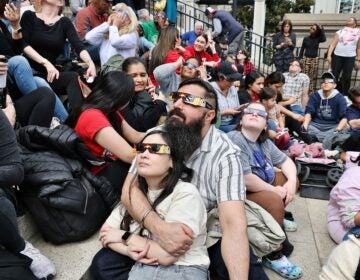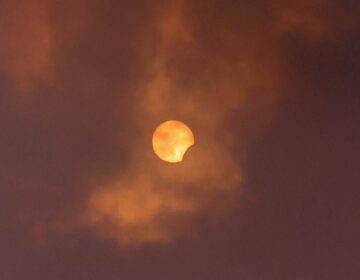Solstice oh-so-bittersweet
ListenFriday marks the official start of summer, but the advent also brings the curtain down on the growing sunrise to sunset duration. Night sky viewing this week includes the opportunity to observe Venus and Mercury in fairly close proximity Thursday. Saturn not far from the moon tomorrow and Wednesday evening. Here’s your chance to send a message to Major Tom: Lone Signal is a METI project in which anybody can send a message representing humanity to Gliese 526, a potentially habitable solar system located a mere 17.6 light years away.
June 17, 2013
[Dave Heller] Summer season for many kicked off Memorial Day weekend, and now the calendar’s catching up. Let’s make it official with Derrick Pitts, chief astronomer at the Franklin Institute. Derrick, to make it official, let’s look to Friday.
[Derrick Pitts] Coming up as you said on this Friday at 1:04 a.m., so we get really almost a full day for the first day of summer this year. And we talk about the first day of summer, and we talk about how it happens on a particular day or happens at a specific time on that day. And the way I always like to describe this is that we’re speaking about a particular instant in time when the Earth reaches as particular point in its orbit around the sun. And so we get to that point at 1:04 a.m. this Friday. Now we recognize that the season, of course, lasts from this Friday all the way up until September when we cross again into autumn. And that’s again a specific point in the Earth’s orbit around the sun. But as we come to this point for summer, we realize that we now have a situation where the Earth is reaching its greatest maximum tilt, if you will, toward the sun.
Is that precisely what happens at precisely 1:04?
That is precisely what happens at precisely 1:04.
Well we’re marking a beginning and it’s always a little poignant too, because in a sense we’re marking the beginning of an end.
You know Dave, that is the other part about it. In the U.K. the way this is done is they start thinking about summer as being right at the beginning of May. So then this date marks mid-summer for them.
You sure they aren’t just dreaming?
[Laughs] They might be dreaming. It is a wonderful dream. But in any case, what this point marks is that sunsets begin to come earlier and earlier and earlier. They still have sunrises sort of dwelling at their very early point, but now we’ll start to see that the number of minutes of daylight starts to decrease as we move on through what we think of as the glorious summer season. So if we want to enjoy really long, beautiful summer evenings, we should be doing that right now. Because from this point on, we’ll start to lose minutes from sunset.
-

Photo by Flickr user Jess Pac
So how ’bout this week with some of the shortest nights? What’s available to be seen?
Well on these really short nights it’s a really great time to look for planets in the long evening hours. So over on the western horizon we have Mercury and Venus. They’ll be pretty close to each other Thursday night this week, but we can also look for Saturn and the moon close together tomorrow night and Wednesday night. We’ll find the moon on one side of Saturn (the western side of Saturn) tomorrow night, and then we’ll find the moon on the eastern side of Saturn on Wednesday night. Then Thursday night Mercury and Venus are close together, low in the West about 45 minutes after sunset, and of course, it’s always a great evening to look for planets anyway.
Derrick, I’ve got a song in my head. It’s the 1963 Chuck Berry classic, “Long distance information, give me Memphis, Tennessee. Help me find the party trying to get in touch with me…”
Now let’s fast-forward half-a-century: long distance is going to get really long. Who’s the party we’re trying to get in touch with?
Well the party we’re trying to get in touch with is actually are any inhabitants of a very, very distant planetary system called Gliese 526.
Oh my gosh, what’s that call going to cost?!
It’s going to be pretty cheap in fact, because what’s going to happen is a particular company called Lone Signal is going to allow people to piggyback their own tweet or text message on board a signal they’ll be broadcasting 17.6 million lightyears away toward the constellation Bootes where this star system is found, and they’re going to be broadcasting a signal in an effort to try to see if there’s any intelligent life capable of long distance communication out there. So what this really is a project that’s similar to SETI, the search for extraterrestrial intelligence. In this case it’s METI: it is messaging extraterrestrial intelligence. So this is actively sending messages out to places where there may be some possibility of intelligent life with the idea of establishing communications. So let’s say for example you connect with this group, Lone Signal, and you send a message, send a tweet or send a text, you’re actually allowed to send one free text or tweet with them first time around, but it’s going to take 17.6 years to get there. One of the services that they will provide is they will mirror your message so that you can actually go to a website and see what kind of progress your message is making toward the Gliese 526 system.
Call me paranoid, but the message that comes to mind for me is: “Spare me when you come to conquer humanity!”
[Laughs] Yes there is that risk, and there is some concern about that. But the truth of the matter is that 17.6 lightyears away, there’s all kinds of issues around this enormous distance that has to be travelled. I mean, 17.6 years doesn’t sound like much when you’re travelling at the speed of light, but if you’re only travelling at half the speed of light, then that makes it 40 years almost, and then if you’re travelling at a quarter it’s 80 years, and in short order you’re talking about generational travel throughout the galaxy. And that’s something that civilizations, as far as we know, our civilization is no where near being able to do anything like this. So why should we suppose that send a signal that will attract some creatures from some place else to come here?
All right, I have a new message: “Happy summer solstice!”
I really like that, and the same to you.
Watch: Time lapse video of Lone Signal Dish, Motion 1
WHYY is your source for fact-based, in-depth journalism and information. As a nonprofit organization, we rely on financial support from readers like you. Please give today.




